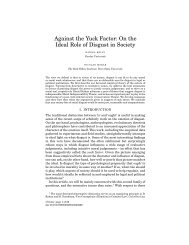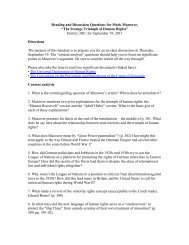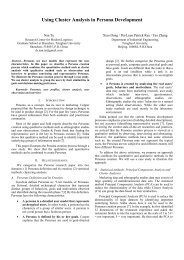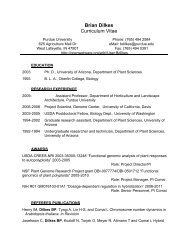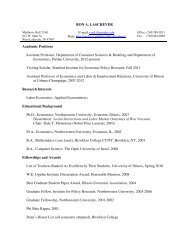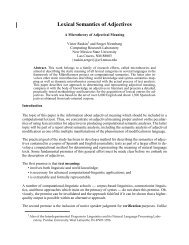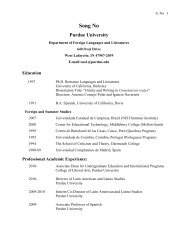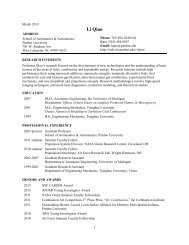The Dopamine Hypothesis of Schizophrenia: An Historical and ...
The Dopamine Hypothesis of Schizophrenia: An Historical and ...
The Dopamine Hypothesis of Schizophrenia: An Historical and ...
Create successful ePaper yourself
Turn your PDF publications into a flip-book with our unique Google optimized e-Paper software.
52 ■ PPP / Vol. 18, No. 1 / March 2011<br />
<strong>of</strong> the original DHS in two major ways. First, this<br />
proposal increased the anatomic specificity <strong>of</strong> the<br />
original hypothesis proposing specific pathways or<br />
regions for the action <strong>of</strong> DA. Second, <strong>and</strong> more<br />
radically, it reversed the direction <strong>of</strong> the original<br />
hypothesis with respect to one <strong>of</strong> these major DA<br />
tracts.<br />
Figure 2 outlines the changes in the DHS as<br />
articulated by Davis et al. Note that the apex <strong>of</strong><br />
the figure is yet more abstract <strong>and</strong> reads “DHS =<br />
dysregulation <strong>of</strong> DA in brain.” <strong>The</strong> boxes under<br />
the mesocortical DA system now read “decreased<br />
turnover” or “decreased post-synaptic receptor<br />
function.”<br />
Attempts at Empirical Evaluation <strong>of</strong><br />
the DHS—Summary<br />
We could not summarize herein all studies relevant<br />
to the DHS, reviews <strong>of</strong> which continue to<br />
appear regularly in the psychiatric literature (e.g.,<br />
Abi-Dargham 2004; Hietala <strong>and</strong> Syvalahti 1996;<br />
Willner 1997). For example, we have not examined<br />
studies <strong>of</strong> plasma levels <strong>of</strong> HVA, which may<br />
help to evaluate a “global” DHS. Surprisingly, no<br />
meta-analyses or detailed reviews <strong>of</strong> this literature<br />
were found. Several (Garcia et al. 1989; Maas et<br />
al. 1993; Zhang et al. 2001) but not all studies<br />
(Steinberg et al. 1993) report elevated levels <strong>of</strong><br />
plasma HVA in schizophrenic versus control subjects.<br />
However, a minority <strong>of</strong> plasma HVA comes<br />
from central DA neurons (Amin et al. 1995). Furthermore,<br />
plasma HVA levels can be substantially<br />
influenced by state variables (Csernansky <strong>and</strong><br />
Newcomer 1994), such as diet (Donnelly et al.<br />
1996; Kendler et al. 1983), exercise (Kendler et al.<br />
1983), <strong>and</strong> mental stress (Sumiyoshi et al. 1999).<br />
Studies <strong>of</strong> plasma HVA are unlikely to provide<br />
definitive evidence about the validity <strong>of</strong> the DHS.<br />
We also have not reviewed the empirical literature<br />
favoring the role <strong>of</strong> DA in neuroleptic action.<br />
We do not dispute the strength <strong>of</strong> this evidence,<br />
but argue (see below) that it is <strong>of</strong> limited relevance<br />
to an evaluation <strong>of</strong> the DHS.<br />
Table 2 summarizes the empirical tests <strong>of</strong> the<br />
DHS that we have evaluated. Two summary points<br />
are noteworthy. First, overall, the DHS has performed<br />
poorly. Few <strong>of</strong> its predictions have been<br />
empirically validated (although we do not claim<br />
that the quality <strong>of</strong> these tests has been uniformly<br />
high or that we have reviewed all the relevant<br />
information). Second, many <strong>of</strong> these tests were<br />
not evaluating the same scientific hypothesis.<br />
Some were testing the IT version <strong>of</strong> the DHS <strong>and</strong><br />
others the IRF version. Some were testing regional<br />
versions <strong>of</strong> the DHS <strong>and</strong> other global versions.<br />
In seeking a perspective on the current status<br />
<strong>of</strong> the DHS, we could find no more appropriate<br />
view than this recent quote from in a text edited by<br />
Carlsson <strong>and</strong> Lecrubier (2004, 99) from original<br />
comments by Stahl:<br />
In spite <strong>of</strong> much research effort over more than 30<br />
years, direct evidence for changes in brain dopamine<br />
concentrations or in dopamine receptor densities<br />
remained frustratingly intangible. However, in recent<br />
years a new lease <strong>of</strong> life has been given to this hypothesis.<br />
. . . Rather than seeing dopamine hyperactivity as a<br />
primary source <strong>of</strong> pathology in schizophrenia, we now<br />
see this rather as a vector <strong>of</strong> a more complex primary<br />
etiology, which allows the expression <strong>of</strong> psychotic<br />
symptomatology. In this model, the primary deficit<br />
would lie in inappropriate information processing in the<br />
prefrontal cortex, perhaps through structural anomalies<br />
in synaptic organization during development, perhaps<br />
due to plastic changes in connectivity involving<br />
anomalies in glutamatergic transmission. In addition,<br />
the abnormalities in dopaminergic neurotransmission<br />
may be better considered as dysregulation rather than<br />
hyperactivity, with certain symptoms, particularly cognitive<br />
ones being related to insufficient dopaminergic<br />
activity in the cortex.<br />
<strong>The</strong> simpler form(s) <strong>of</strong> the DHS—as originally<br />
postulated—are difficult to recognize in this formulation.<br />
Consistent with Davis’s modification,<br />
the emphasis is on DA “dysregulation” rather<br />
than hyperactivity. DA abnormalities are no longer<br />
given etiologic primacy, which in this account<br />
seems to have been shifted to glutamate. If this<br />
reflects a “new lease on life” for the DHS, it is<br />
in the form <strong>of</strong> a substantially altered theory, <strong>and</strong><br />
even more likely, as a virtual replacement <strong>of</strong> the<br />
original DHS. This is an issue we return to toward<br />
the end <strong>of</strong> the next section.<br />
Philosophical <strong>An</strong>alysis<br />
How successful has the DHS been <strong>and</strong>, by<br />
what criteria should we evaluate its performance?<br />
Trying to answer this question leads us through<br />
several major theories <strong>of</strong> scientific progress <strong>and</strong> to<br />
two further questions: (i) Would a more produc-



